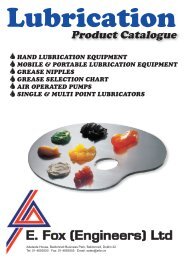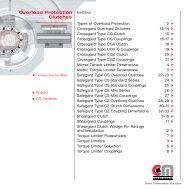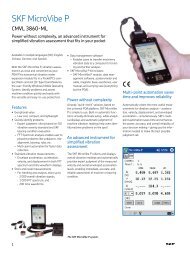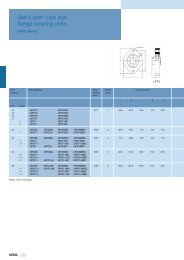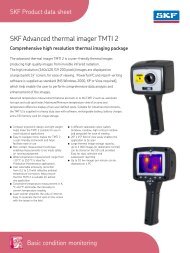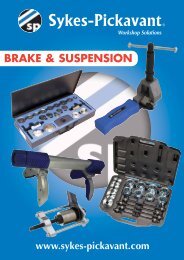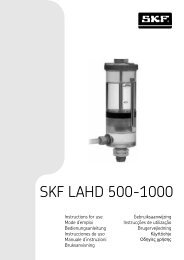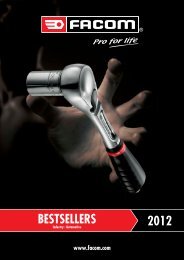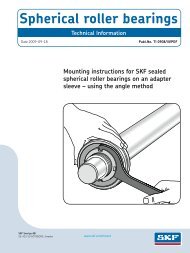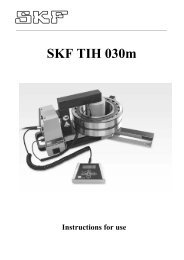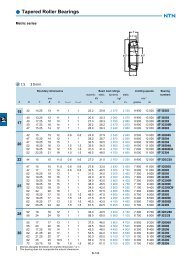PDF catalog - Who-sells-it.com
PDF catalog - Who-sells-it.com
PDF catalog - Who-sells-it.com
You also want an ePaper? Increase the reach of your titles
YUMPU automatically turns print PDFs into web optimized ePapers that Google loves.
Taper Bushes<br />
CROSS+MORSE<br />
Taper bushes provide a low cost, simple, quick method of<br />
securing sprocket, pulleys and couplings to a wide range of<br />
standard metric and imperial dimensioned shafts of general<br />
<strong>com</strong>mercial tolerances and finish.<br />
The taper surfaces on the bush and mating hub are driven<br />
together by high tensile screws, causing the spl<strong>it</strong> bush to be<br />
firmly contracted onto the shaft. The strong clamping force<br />
which can be achieved enables transmission of high torque<br />
w<strong>it</strong>hout the problems of fretting associated w<strong>it</strong>h simple<br />
keyseated drives.<br />
The design ensures quick, easy installation of sprockets and<br />
pulleys onto shafts w<strong>it</strong>h simple pos<strong>it</strong>ioning for alignment.<br />
Pos<strong>it</strong>ive jacking-off of the bush during removal ensures quick<br />
disassembly w<strong>it</strong>hout normal problems of seizure between shaft<br />
and pulley. The standard bushes shown oppos<strong>it</strong>e are su<strong>it</strong>able<br />
for taper bore sprockets shown on pages 28-33, taper bored<br />
hubs on page 64, and the taper bored pulleys offered in the<br />
timing belt <strong>catalog</strong>ue.<br />
Instructions - Installation and Removal<br />
Installation<br />
1. Remove protective coating from the bore and outside<br />
bush, and bore of hub. After ensuring the mating tapered<br />
surfaces are <strong>com</strong>pletely clean, insert bush in hub so that<br />
holes line up.<br />
2. Oil thread and point of grub screws, or thread and under<br />
head of cap screws. Place screws loosely in holes threaded<br />
in hub, shown thus in diagram.<br />
3. Clean shaft and f<strong>it</strong> hub and bush to shaft. Locate in<br />
pos<strong>it</strong>ion, remembering bush will nip the shaft first and<br />
then hub will be drawn on to the bush.<br />
4. Using a hexagon wrench tighten screws gradually and<br />
alternately until all are pulled up very tightly. Use a piece<br />
of pipe on wrench to increase leverage.<br />
5. When a key is not used, hammer against large end of bush<br />
using a block or sleeve to prevent damage. Screws will<br />
now turn a l<strong>it</strong>tle more. Repeat this alternate hammering<br />
and screw tightening once or twice. After drive has run<br />
under load for a short time, check tightness of screws.<br />
6. If a key is to be f<strong>it</strong>ted, do so after the bush has been<br />
tightened on to the shaft, and then f<strong>it</strong> a parallel key that is<br />
side f<strong>it</strong>ting w<strong>it</strong>h top clearance.<br />
7. Fill empty holes w<strong>it</strong>h grease to exclude dirt.<br />
Installation and Design Re<strong>com</strong>mendations<br />
34<br />
Removal<br />
Power Transmission Solutions<br />
1. Slacken all screws by several turns, remove one or two<br />
according to number of jacking off holes thus in<br />
diagram. Insert screws in jacking off holes after oiling<br />
thread and point of grub screws or thread under head<br />
of cap screws.<br />
2. Tighten screws alternately until bush is loosened in hub<br />
and assembly is free on the shaft.<br />
3. Remove assembly from shaft.<br />
Bush w<strong>it</strong>h 2 Grub Screws<br />
(Sizes 1008-3030)<br />
Bush w<strong>it</strong>h 3 Grub Screws<br />
(Sizes 3535 and above)<br />
It is re<strong>com</strong>mended that a key should be f<strong>it</strong>ted w<strong>it</strong>h bushes in rigid and flexible couplings, timing belt and chain drives, and<br />
wherever loads of a heavy pulsating nature are encountered. All keyways are parallel keyways to Br<strong>it</strong>ish Standard 4235 Part 1 : 1972<br />
for metric dimensional shafts, or Br<strong>it</strong>ish Standard 46 Part 1 : 1958 for imperial dimensional shafts, w<strong>it</strong>h the exception of those<br />
marked* in the tables which are slightly shallower. Where a key is used <strong>it</strong> should be parallel type w<strong>it</strong>h side f<strong>it</strong>ting and top<br />
clearance.<br />
It is not re<strong>com</strong>mended to use taper bushes w<strong>it</strong>h maximum or minimum bore sizes on drives where high shock loads may be<br />
encountered.<br />
T el +44 121 360 0155 Fax +44 121 325 1079 Email sales@crossmorse.<strong>com</strong><br />
CD Contents<br />
Catalogue Selection INDEX<br />
Transmissions :<br />
INDEX<br />
BACK<br />
NEXT




